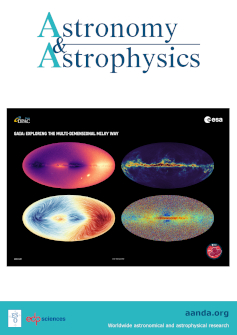Intrinsic line profiles for X-ray fluorescent lines in SKIRT
IF 5.4
2区 物理与天体物理
Q1 ASTRONOMY & ASTROPHYSICS
引用次数: 0
Abstract
Context. X-ray microcalorimeter instruments are expected to spectrally resolve the intrinsic line shapes of the strongest fluorescent lines. X-ray models should therefore incorporate these intrinsic line profiles to obtain meaningful constraints from observational data.Aims. We included the intrinsic line profiles of the strongest fluorescent lines in the X-ray radiative transfer code SKIRT to model the cold-gas structure and kinematics based on high-resolution line observations from XRISM/Resolve and Athena/X-IFU.Methods. The intrinsic line profiles of the Kα and Kβ lines of Cr, Mn, Fe, Co, Ni, and Cu were implemented based on a multi-Lorentzian parameterisation. Line energies are sampled from these Lorentzian components during the radiative transfer routine.Results. In the optically thin regime, the SKIRT results match the intrinsic line profiles as measured in the laboratory. With a more complex 3D model that also includes kinematics, we find that the intrinsic line profiles are broadened and shifted to an extent that will be detectable with XRISM/Resolve; this model also demonstrates the importance of the intrinsic line shapes for constraining kinematics. We find that observed line profiles directly trace the cold-gas kinematics, without any additional radiative transfer effects.Conclusions. With the advent of the first XRISM/Resolve data, this update to the X-ray radiative transfer framework of SKIRT is timely and provides a unique tool for constraining the velocity structure of cold gas from X-ray microcalorimeter spectra.SKIRT 中 X 射线荧光线的本征线剖面图
背景X 射线微量热计仪器有望从光谱上解析最强荧光线的固有线形。因此,X 射线模型应包含这些固有线剖面,以便从观测数据中获得有意义的约束。我们根据 XRISM/Resolve 和 Athena/X-IFU 的高分辨率线观测数据,将最强荧光线的本征线剖面纳入 X 射线辐射传递代码 SKIRT,以建立冷气体结构和运动学模型。铬、锰、铁、钴、镍和铜的 Kα 和 Kβ 线的固有线剖面是在多洛伦兹参数化的基础上实现的。在辐射传递过程中,从这些洛伦兹成分中采样线能量。在光学稀薄区,SKIRT 的结果与实验室测量的固有线剖面相吻合。通过一个更复杂的三维模型(也包括运动学),我们发现固有线剖面被拓宽和偏移,其程度可以用 XRISM/Resolve 检测到;这个模型也证明了固有线形状对于约束运动学的重要性。我们发现,观测到的线剖面可以直接追踪冷气体运动学,而不需要任何额外的辐射传递效应。随着第一批 XRISM/Resolve 数据的出现,对 SKIRT 的 X 射线辐射传递框架的更新非常及时,它为从 X 射线微量热计光谱中约束冷气体的速度结构提供了一个独特的工具。
本文章由计算机程序翻译,如有差异,请以英文原文为准。
求助全文
约1分钟内获得全文
求助全文
来源期刊

Astronomy & Astrophysics
地学天文-天文与天体物理
CiteScore
10.20
自引率
27.70%
发文量
2105
审稿时长
1-2 weeks
期刊介绍:
Astronomy & Astrophysics is an international Journal that publishes papers on all aspects of astronomy and astrophysics (theoretical, observational, and instrumental) independently of the techniques used to obtain the results.
文献相关原料
| 公司名称 | 产品信息 | 采购帮参考价格 |
|---|
 求助内容:
求助内容: 应助结果提醒方式:
应助结果提醒方式:


